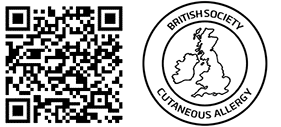
What are the aims of this leaflet?
This leaflet has been written to help you understand more about patch testing. It tells you what a patch test is, what is tested and what is involved.
What is patch testing?
Patch testing is a specialist procedure carried out in dermatology departments to find out whether your skin condition is caused, or made worse, by an allergy to substances which have come into contact with your skin. This is called contact allergy. Substances that cause an allergic reaction are called allergens. They may be found both at home and at work.
Patch tests will not detect food allergies.
What will be tested?
Many thousands of substances can cause a reaction. However, the most common 50 or so which may come in contact with the skin, either intentionally or by accident, include metals, perfumes, rubber chemicals, preservatives, cosmetics and plants. Additional substances are often added to this list if it is thought they may be causing your skin condition. You may also be tested with specific items with which you come into contact at home, at work or socially, such as personal toiletries.
What should I bring to the patch test clinic?
On the first appointment please bring:
- A list of all your medications - any prescribed drugs you are taking.
- All the ointments and creams you have been prescribed.
- Your own products -all the items you use at home which could be causing or worsening your skin condition, such as toiletries, cosmetics, perfumes, nail and hair products. You may have bought them, or you may have been given them. If you put any products directly on your skin then please bring both the product, and the packaging showing the listed ingredients. For other items such as household cleansers, washing powder and fabric softeners, it is only necessary to bring the packaging showing the list of ingredients. If you have been asked to bring any particular products or substances, it is important to remember to bring these with you to all appointments.
- Products and chemicals used at work - if you think that substances at work may be making your skin condition worse, please bring in the Health and Safety Data sheets (sometimes called the COSHH sheets) for these products. These will be available at your place of work, but you may need to ask the Health and Safety officer for them. You may be asked to bring samples of these products for testing, if necessary.
- Please note that not all of your ‘own’ products will be tested on the skin.
What does patch testing involve?
- You will need to attend the hospital: typically for 3 appointments during a one-week period. Individual centres may have a variation in the days on which you are seen.
- On the first visit, each substance to be tested will be applied to your back in special small disc (about 1cm in diameter) containers or square chambers (patches), held in place by hypoallergenic tape (tape that cannot cause an allergic reaction). The location of the patches is identified by marking your back with ink. Occasionally the arms or the thighs are also used for patch testing. Itching of the test areas is normal, but you are advised not to scratch. You should allow up to 2 hours for the first visit.

- The substances will remain taped in place for 48 hours, or until your second visit. Any reactions are noted at the second visit. Additional patches are sometimes added at this visit. The marking ink and/or tape must remain on your back for at least a further two days. It may be necessary to use an ultraviolet light on part of your arm or back to at this second visit if a reaction to sunlight is suspected. This is called ‘photopatch testing’.
- Some allergens are pigments (colour) or dyes, and they will therefore leave a temporary mark on the skin.
- On the third visit, the skin of your back will be checked (examined) and, if there are any reactions, they will be discussed with you.
- It is possible that your patch tests will be negative, which is also very helpful to you and your doctor, as contact allergy will be less likely to be a cause of your skin problem.
- Your doctor may decide not to patch test if any of the following conditions apply:
- You are pregnant or breastfeeding.
- You have extensive eczema on your back or other skin conditions.
- You have used a sunbed/been sunbathing in the previous 6 weeks.
- You are taking a moderate or high dose of prescribed steroid tablets.
- You have applied steroid ointments or creams to your back within 72 hours before the appointment
- You are taking other drugs which suppress the immune system.
If in doubt or if any of these apply, please telephone the clinic.
What does a positive patch test look like?
- A positive patch test is a red or pink, itchy, often raised area of skin where a substance was applied. This usually disappears after a few days once the substance is removed.
- A strongly positive patch test can sometimes cause a local blister which may last for several weeks.
- A reaction can occasionally occur after the 3rd appointment. If you do develop a late reaction, please take photographs and contact your clinic.
Do not:
- Do not apply ointment/cream to your back on the morning of the test.
- Do not get your back wet or bathe, swim or shower during the week of the tests. A cool shallow bath is a good alternative.
- Do not wear your best clothes or pale-coloured clothing as the tests and the marker ink may permanently stain clothing.
- Do not expose your back to the sun or artificial sunlight (sun lamps) during testing.
- Do not participate in sports or any heavy physical work during the week of the tests, as sweating may cause the patches to fall off.
Do:
- Do wear old bras, tops or shirts for the week of the tests and wear a shirt or vest to sleep in to protect the patches. Clothes that open at the front can be easier to take on and off than those which go over your head.
- If a patch starts to peel off, tape the edges down using the tape you have been given by the clinic. If a whole patch comes loose, remove it, note the time and date, and take a photo of the area to take to the clinic.
- Take a photo of your back if you think a late reaction has occurred and contact your hospital contact.
- Continue to take antihistamines if required (unless asked not to).
- Contact your clinic if you are concerned.
What side effects may occur?
Side effects are rare, but include:
- Persistent reaction - some positive test reactions may remain for a few weeks before fading away.
- Flare-up of eczema - a positive patch test may be accompanied by a temporary flare-up of your existing or previous eczema.
- Pigment change - an increase or decrease in pigment (skin colour) may be seen at the place where the patches were, which may last for several months.
- Scarring - very rare (1 in 10,000).
- Allergy - very uncommon (1 in 5000), you may become allergic to one of the substances applied during patch testing. If this happens, you will be advised how to avoid the substance.
Storage of patch test results
Patch test results are often recorded in a computer database and compared to the results of patch testing nationally to improve testing across the country. The anonymised results may be used for studies and shared with other medical centres.
Where can I get more information about patch testing?
Web links to other relevant resources:
https://cutaneousallergy.org/patient-information-leaflets/

https://dermnetnz.org/topics/patch-tests
Jargon Buster: www.skinhealthinfo.org.uk/support-resources/jargon-buster/
Please note that the British Association of Dermatologists (BAD) provides web links to additional resources to help people access a range of information about their treatment or skin condition. The views expressed in these external resources may not be shared by the BAD or its members. The BAD has no control of and does not endorse the content of external links.
This leaflet aims to provide accurate information about the subject and is a consensus of the views held by representatives of the British Society for Cutaneous Allergy and the British Association of Dermatologists: individual patient circumstances may differ, which might alter both the advice and course of therapy given to you by your doctor.
This leaflet has been assessed for readability by the British Association of Dermatologists’ Patient Information Lay Review Panel
BRITISH ASSOCIATION OF DERMATOLOGISTS PATIENT INFORMATION LEAFLET
PRODUCED | JUNE 2010
UPDATED | AUGUST 2013, OCTOBER 2016, JUNE 2020, JULY 2024
NEXT REVIEW DATE | JULY 2027
Download a PDF of this page using the link below:
Download File